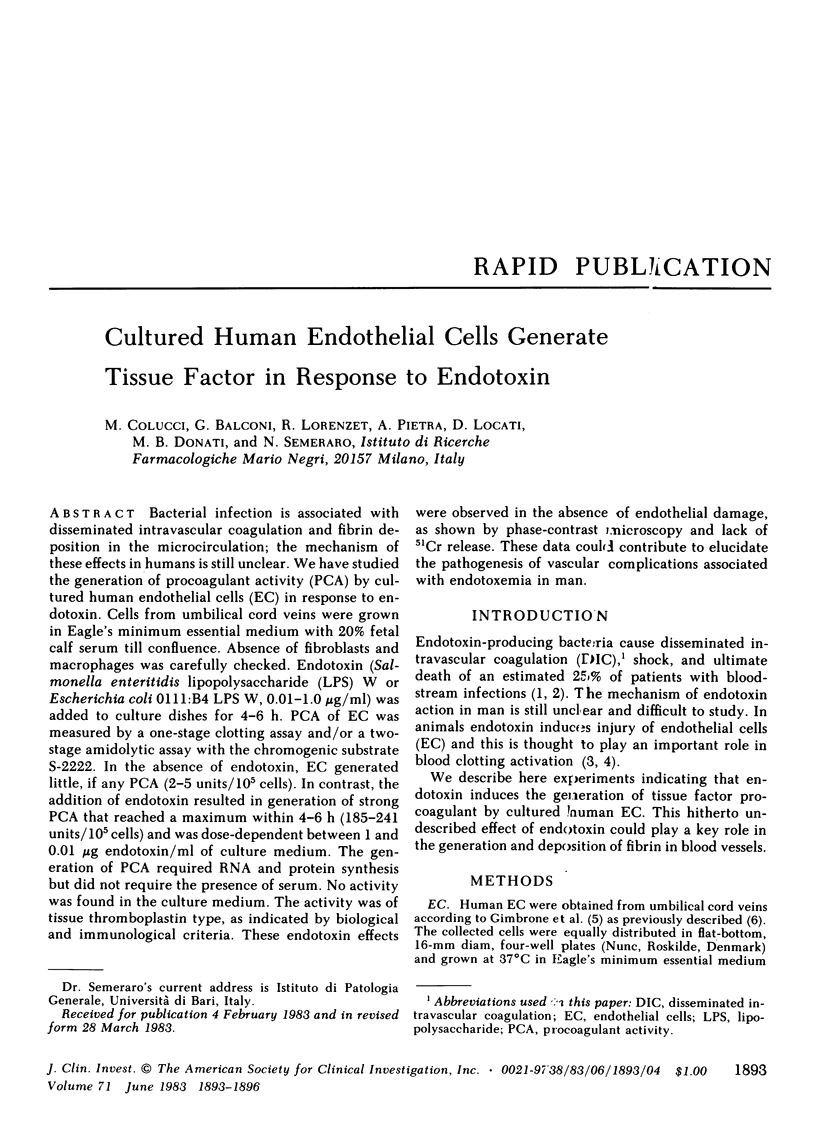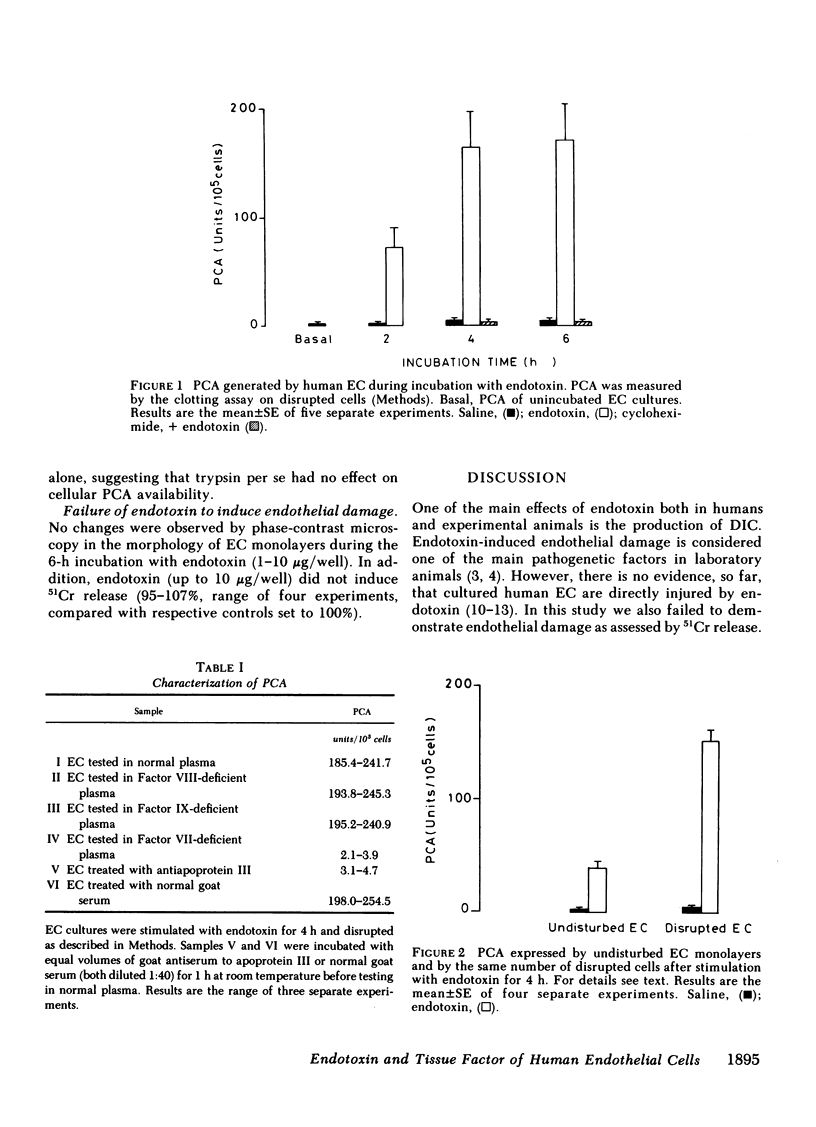Abstract
Bacterial infection is associated with disseminated intravascular coagulation and fibrin deposition in the microcirculation; the mechanism of these effects in humans is still unclear. We have studied the generation of procoagulant activity (PCA) by cultured human endothelial cells (EC) in response to endotoxin. Cells from umbilical cord veins were grown in Eagle's minimum essential medium with 20% fetal calf serum till confluence. Absence of fibroblasts and macrophages was carefully checked. Endotoxin (Salmonella enteritidis lipopolysaccharide (LPS) W or Escherichia coli 0111:B4 LPS W, 0.01-1.0 micrograms/ml) was added to culture dishes for 4-6 h. PCA of EC was measured by a one-stage clotting assay and/or a two-stage amidolytic assay with the chromogenic substrate S-2222. In the absence of endotoxin, EC generated little, if any PCA (2-5 units/10(5) cells). In contrast, the addition of endotoxin resulted in generation of strong PCA that reached a maximum within 4-6 h (185-241 units/10(5) cells) and was dose-dependent between 1 and 0.01 microgram endotoxin/ml of culture medium. The generation of PCA required RNA and protein synthesis but did not require the presence of serum. No activity was found in the culture medium. The activity was of tissue thromboplastin type, as indicated by biological and immunological criteria. These endotoxin effects were observed in the absence of endothelial damage, as shown by phase-contrast microscopy and lack of 51Cr release. These data could contribute to elucidate the pathogenesis of vascular complications associated with endotoxemia in man.
Full text
PDF



Selected References
These references are in PubMed. This may not be the complete list of references from this article.
- Barbieri B., Balconi G., Dejana E., Donati M. B. Evidence that vascular endothelial cells can induce the retraction of fibrin clots. Proc Soc Exp Biol Med. 1981 Nov;168(2):204–207. doi: 10.3181/00379727-168-41260. [DOI] [PubMed] [Google Scholar]
- Colucci M., Curatolo L., Donati M. B., Semeraro N. Cancer cell procoagulant activity: evaluation by an amidolytic assay. Thromb Res. 1980 May 1;18(3-4):589–595. doi: 10.1016/0049-3848(80)90359-x. [DOI] [PubMed] [Google Scholar]
- Galdal K. S., Evensen S. A. Effects of divalent cations and various vasoactive and haemostatically active agents on the integrity of monolayers of cultured human endothelial cells. Thromb Res. 1981 Feb 1;21(3):273–284. doi: 10.1016/0049-3848(81)90165-1. [DOI] [PubMed] [Google Scholar]
- Mantovani A., Jerrells T. R., Dean J. H., Herberman R. B. Cytolytic and cytostatic activity on tumor cells of circulating human monocytes. Int J Cancer. 1979 Jan 15;23(1):18–27. doi: 10.1002/ijc.2910230105. [DOI] [PubMed] [Google Scholar]
- Maynard J. R., Dreyer B. E., Stemerman M. B., Pitlick F. A. Tissue-factor coagulant activity of cultured human endothelial and smooth muscle cells and fibroblasts. Blood. 1977 Sep;50(3):387–396. [PubMed] [Google Scholar]
- Morrison D. C., Ulevitch R. J. The effects of bacterial endotoxins on host mediation systems. A review. Am J Pathol. 1978 Nov;93(2):526–618. [PMC free article] [PubMed] [Google Scholar]
- Smariga P. E., Maynard J. R. Platelet effects on tissue factor and fibrinolytic inhibition of cultured human fibroblasts and vascular cells. Blood. 1982 Jul;60(1):140–147. [PubMed] [Google Scholar]
- Wolff S. M., Bennett J. V. Editorial: Gram-negative-rod bacteremia. N Engl J Med. 1974 Oct 3;291(14):733–734. doi: 10.1056/NEJM197410032911411. [DOI] [PubMed] [Google Scholar]
- Yamada O., Moldow C. F., Sacks T., Craddock P. R., Boogaerts M. A., Jacob H. S. Deleterious effects of endotoxin on cultured endothelial cells: an in vitro model of vascular injury. Inflammation. 1981 Jun;5(2):115–126. doi: 10.1007/BF00914201. [DOI] [PubMed] [Google Scholar]


